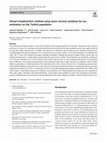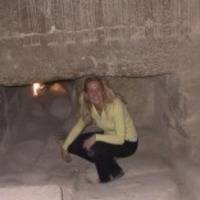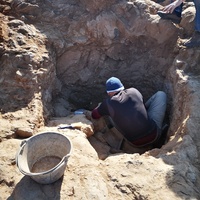Papers by julieta García-Donas
Journal of Oral Biosciences, Oct 31, 2023
This study compares cranial measurements between different populations from Ibiza and other popul... more This study compares cranial measurements between different populations from Ibiza and other populations from Spain in an attempt to search for evidences of secular changes through time. The similarities and differences between the groups based on craniometrics are reported and discussed. Although the limitations of this study make impossible to draw conclusions, our findings give a new insight into the biological variation in Ibiza

Legal Medicine
Population affinity estimation is an important step in the identification of unknown individuals.... more Population affinity estimation is an important step in the identification of unknown individuals. To ensure accurate results, validation studies of newly developed methods must be performed using different target populations and skeletal elements. This research aimed to determine the accuracy and reliability of population affinity estimation on a modern Spanish sample using two online software applications. The sample consisted of 114 adult individuals (51 males, 63 females) using 38 measurements and one angle from the skull and mandible. AncesTrees was used for craniometric measurements and (hu)MANid for mandibular variables with different classification models and probability thresholds being evaluated. The required parameters were inputted for each individual and statistics were generated to assess the accuracy of the estimation. AncesTrees performed with the greatest accuracy as the program correctly classified the sample as Southwestern European or European, with highest accuracies being 54.56% (trial 1), 86.05% (trial 2), 82.61% (trial 3), 34.55% (trial 4) and 100% (trial 5). (hu)MANid correctly classified the sample as being from white origin with accuracies ranging from 70.59% to 80% without considering correct sex estimation, while accuracy ranged between 62.75% and 80% accounting for estimated sex. Population affinity estimation may determine subsequent methods used in the construction of the biological profile. Our results demonstrated varying accuracy rates depending on the element and method, offering a critical view in relation to software applicability and validity. Reference populations and intrinsic and extrinsic factors can potentially influence the method accuracy and reliability. Future research should focus on the inclusion of underrepresented groups.
Translational Research in Anatomy, 2020
This project is an innovative mixture of medical imaging and forensics with holography, animation... more This project is an innovative mixture of medical imaging and forensics with holography, animation, art and virtual reality. This alliance of art and science explores, presents and communicates the history of violence and the violence of history to diverse audiences. Anatomical detail provides the substrate for forensic analysis and interpretation while digital technologies and creative art nourish fictitious scenarios on unexplained historical crimes. The aesthetics of the virtual world create an immersive environment for diverse audiences. The emotional, ethical and aesthetic impact of violence becomes a site of reflection, empathy, learning and performative imagination.
Biology, Apr 19, 2023
This article is an open access article distributed under the terms and conditions of the Creative... more This article is an open access article distributed under the terms and conditions of the Creative Commons Attribution (CC BY

Biology
Histomorphometry constitutes a valuable tool for age estimation. Histological interpopulation var... more Histomorphometry constitutes a valuable tool for age estimation. Histological interpopulation variability has been shown to affect the accuracy of age estimation techniques and therefore validation studies are required to test the accuracy of the pre-existing methodologies. The present research constitutes a validation study of widely known histological methods on the sixth rib and the femoral midshaft of a 19th century British population originating from Blackburn, England. An evaluation of the histomorphometric features of eleven ribs and five femora was performed and used to test the accuracy of selected methods. Results indicated that osteon area and circularity were the only histomorphometric variables that presented significant interpopulation variability. Cho et al.’s method for the ribs and the average value produced using Kerley and Ubelaker’s method for intact osteon and percentage of lamellar bone equations for femur were considered the only reliable markers for estimatin...

Introduction: Histomorphometry has been extensively applied for estimating age-atdeath. Although ... more Introduction: Histomorphometry has been extensively applied for estimating age-atdeath. Although ribs have been commonly used for histological age, other bones need to be considered in order to contemplate possible bone specific remodelling rates and various recovery scenarios. Materials and Methods: Thirty-two left clavicle midshaft fragments were obtained from routine autopsies conducted at the Institute of Forensic Medicine (Albania, 2014-2015). Thin-sections of 0.5-1mm were prepared using standard protocols. Thirteen histomorphometric variables were collected using a Reflected Light Microscope and data were analysed using JASP 9.0.1. Results: Bayes factor showed that the existence of positive correlation of OPD with age is 348,050 times more likely than the lack of correlation. In addition, Mean Perimeter and Mean area are 1.047 and 1.357 times more likely to have a positive correlation with age that the alternative variables. Bayes linear regression was used to compare different predicting models. The best model includes OPD and Osteon Perimeter (R²=0.678, SEE=7.5years) which is 2.388,000 times more likely to explain age than the null model. Discussion: The Bayesian approach allowed the evaluation of the fitness of the model compared to the null model and to better explain the causative relationship of the predictors with age. This study is only the fourth worldwide performed on clavicular histomorphometry and provides unique population specific standards for age estimation of future forensic cases in Albania. The use of RLM as a new technique on forensic bone histology can be further tested and applied on a variety of skeletal elements

Research and Reports in Forensic Medical Science
Forensic anthropologists are faced with many challenges one of which is setting the grounds for t... more Forensic anthropologists are faced with many challenges one of which is setting the grounds for the assessment of an unknown individual's population affinity, an essential element for building a biological profile that can lead to positive identification. A heavy body of literature is dealing with the topic of "race"-in early studies-or "ancestry/population affinity"-in more recent articles-in an effort to provide reliable tools for this challenging task. A great and ongoing debate exists on whether this type of classification should be done at all or whether it should be accepted as a "necessary evil". The over-simplistic categorization of people originating from vast geographical areas without taking into account micro-evolutionary and environmental factors, that are of great importance and influence population affinity, can greatly enhance social discrimination and stigma. On the other hand, it must be stressed that the point of assessing an individual's ancestry or geographic origin in a forensic context is not a matter of taxonomy or population labeling but rather an asset to the identification process, which can help narrow down possible matches from a missing persons' list. In that vein, the current paper offers an overview of different methodological approaches to the matter of ancestry estimation and aims to gather relevant information about the different approaches used, the current advances and the implications of the assessment regarding positive identification.

Introduction: Age-at-death and origin are crucial pieces of information required for the identifi... more Introduction: Age-at-death and origin are crucial pieces of information required for the identification of unknown individuals. Macroscopic, microscopic and laboratory-based analyses are used for these purposes with the choice of the method being critical to ensure accurate results. This research investigates the development of Cretan population-specific methods of identification through bone histology and isotope analysis. Materials and Methods: Fifty-two rib fragments of known age from the Cretan osteological collection were used for this study. Histomorphometric analysis and multiisotope profiles were applied in an effort to explore age related changes and their significance in origin prediction. Moreover, histological and stable isotopes- data were analysed jointly in a small sample set (N=11). Statistical analysis was performed with IBM SPSS 24. Results: Age estimates showed higher accuracy rates using population-specific formulae with a minimum error of 13 years from known age...
Statistics and Probability in Forensic Anthropology, 2020
Abstract The aim of this paper is to provide a methodological guide on how to select, test, and u... more Abstract The aim of this paper is to provide a methodological guide on how to select, test, and use statistical procedures for sex estimation using morphological traits of the cranium expressed on an ordinal scale. R functions were developed to implement binary logistic regression (BLR) and linear discriminant analysis (LDA), and step-by-step instructions with examples from Cretan and Cypriot modern identified skeletal samples were provided to illustrate the potential and limitations of each method. Even though the current case study focused on cranial traits, the R functions provided may be used for any morphological skeletal trait.
Forensic anthropologists are requested to give authorities estimates on the biological characteri... more Forensic anthropologists are requested to give authorities estimates on the biological characteristics of unidentified decomposed remains in an effort to create a physical description that can be compared with a missing person’s profile, eventually leading to positive identification. To answer these questions, scientists traditionally follow a variety of statistical approaches such as frequentist and Bayesian statistics in both analysis and interpretation. The main subject of this chapter is to summarize the frequentist statistical approach and to illustrate with examples the rationale in the method selection and interpretation.
This study compares cranial measurements between different populations from Ibiza and other popul... more This study compares cranial measurements between different populations from Ibiza and other populations from Spain in an attempt to search for evidences of secular changes through time. The similarities and differences between the groups based on craniometrics are reported and discussed. Although the limitations of this study make impossible to draw conclusions, our findings give a new insight into the biological variation in Ibiza.
La Revue de Médecine Légale, 2017
Phase II focuses on geographic origin and uses 20 modern samples from different geographic origin... more Phase II focuses on geographic origin and uses 20 modern samples from different geographic origins and taphonomic contexts. An aDNA protocol was used to maximize the results in degraded modern bones. DNA extraction, library and sequenced using a Shotgunsequencing approach were carried out in genomics laboratories at UCD. The geographic information will be predicted by comparing the results obtained by means of SNP genotypes with databases of known populations. This approach enables the attribution of the samples to different regions and creates a basis for personal identification.

One of the crucial steps for the creation of the biological profile of an individual is the estim... more One of the crucial steps for the creation of the biological profile of an individual is the estimation of age at death. The choice of the method depends on the nature of the remains, the equipment available and the expertise of the forensic anthropologist, among others. In cases of very fragmented remains, microscopic methods remain one of the only approaches that can be applied. This study presents the results obtained from a histological analysis of rib thin-sections from two Mediterranean populations. The sample consists of 88 standard ribs from two Modern samples (Cretan and Greek-Cypriot Collections, N=88, Mean age=60, SD=17.90). The costal elements were processed histologically according to standard protocols. Thirteen variables (both qualitative and quantitative parameters) were assessed. Technical Error Measurement (TEM) analysis was performed to test the repeatability of the histological parameters. A validation study was performed by applying four existing microscopic meth...

International Journal of Legal Medicine, 2021
Sex estimation from skeletal remains is crucial for the estimation of the biological profile of a... more Sex estimation from skeletal remains is crucial for the estimation of the biological profile of an individual. Although the most commonly used bones for means of sex estimation are the pelvis and the skull, research has shown that acceptable accuracy rates might be achieved by using other skeletal elements such as vertebrae. This study aims to contribute to the development of sex estimation standards from a Turkish population through the examination of CT scans from the seven cervical vertebrae. A total of 294 individuals were included in this study. The CT scans were obtained from patients attending the Bakirkoy Training and Research Hospital (Turkey) and the data was collected retrospectively by virtually taking measurements from each cervical vertebrae. The full database was divided into a training set (N = 210) and a validation set (N = 84) to test the fit of the models. Observer error was assessed through technical error of measurement and sex differences were explored using pa...
The anthropological information about past populations allows interpreting the past better and he... more The anthropological information about past populations allows interpreting the past better and helps to understand biological aspects of the present populations. In this study, the demographics of two Roman archaeological populations from Ibiza are presented. Standard osteological methods are used to assess the populations’ biological profile. Sex and age assessment, stature and pathologies and traumatic lesions are reported. The analysis of cranial, postcranial and dental non-metrics traits skeleton is also undertaken. Overall, this provides valuable information about the Roman population from 1st to 7th centuries in the island.
Sex estimation is considered one of the first steps in the forensic identification process. Morph... more Sex estimation is considered one of the first steps in the forensic identification process. Morphological and morphometrical differences between males and females have been used as means for morpho...

Sex estimation is an essential step in the identification process of unknown heavily decomposed h... more Sex estimation is an essential step in the identification process of unknown heavily decomposed human remains as it eliminates all possible matches of the opposite sex from the missing person's database. Osteometric methods constitute a reliable approach for sex estimation and considering the variation of sexual dimorphism between and within populations; standards for specific populations are required to ensure accurate results. The current study aspires to contribute osteometric data on the tibia from contemporary Greek-Cypriots to assist the identification process. A secondary goal involves osteometric comparison with data from Crete, a Greek island with similar cultural and dietary customs and environmental conditions. Left tibiae from one hundred and thirty-two skeletons (70 males and 62 females) of Greek-Cypriots and one hundred and fifty-seven skeletons (85 males, 72 females) of Cretans were measured. Seven standard metric variables including Maximum length (ML), Upper epi...











Uploads
Papers by julieta García-Donas